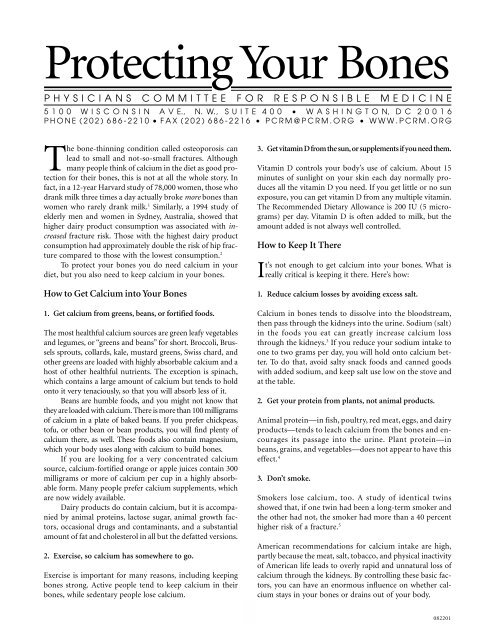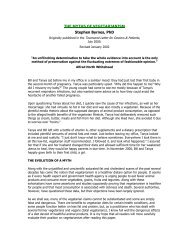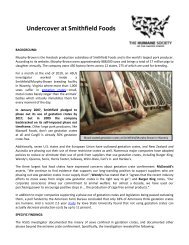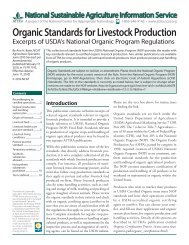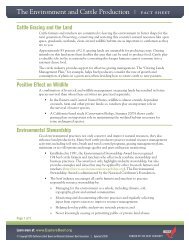Protecting Your Bones
Protecting Your Bones
Protecting Your Bones
Create successful ePaper yourself
Turn your PDF publications into a flip-book with our unique Google optimized e-Paper software.
<strong>Protecting</strong> <strong>Your</strong> <strong>Bones</strong><br />
P H Y S I C I A N S C O M M I T T E E F O R R E S P O N S I B L E M E D I C I N E<br />
5 1 0 0 W I S C O N S I N A V E., N. W., S U I T E 4 0 0 • W A S H I N G T O N, D C 2 0 0 1 6<br />
P H O N E ( 2 0 2 ) 6 8 6 - 2 2 1 0 • F A X ( 2 0 2 ) 6 8 6 - 2 2 1 6 • P C R M @ P C R M . O R G • W W W . P C R M . O R G<br />
The bone-thinning condition called osteoporosis can<br />
lead to small and not-so-small fractures. Although<br />
many people think of calcium in the diet as good protection<br />
for their bones, this is not at all the whole story. In<br />
fact, in a 12-year Harvard study of 78,000 women, those who<br />
drank milk three times a day actually broke more bones than<br />
women who rarely drank milk. 1 Similarly, a 1994 study of<br />
elderly men and women in Sydney, Australia, showed that<br />
higher dairy product consumption was associated with increased<br />
fracture risk. Those with the highest dairy product<br />
consumption had approximately double the risk of hip fracture<br />
compared to those with the lowest consumption. 2<br />
To protect your bones you do need calcium in your<br />
diet, but you also need to keep calcium in your bones.<br />
How to Get Calcium into <strong>Your</strong> <strong>Bones</strong><br />
1. Get calcium from greens, beans, or fortified foods.<br />
The most healthful calcium sources are green leafy vegetables<br />
and legumes, or “greens and beans” for short. Broccoli, Brussels<br />
sprouts, collards, kale, mustard greens, Swiss chard, and<br />
other greens are loaded with highly absorbable calcium and a<br />
host of other healthful nutrients. The exception is spinach,<br />
which contains a large amount of calcium but tends to hold<br />
onto it very tenaciously, so that you will absorb less of it.<br />
Beans are humble foods, and you might not know that<br />
they are loaded with calcium. There is more than 100 milligrams<br />
of calcium in a plate of baked beans. If you prefer chickpeas,<br />
tofu, or other bean or bean products, you will find plenty of<br />
calcium there, as well. These foods also contain magnesium,<br />
which your body uses along with calcium to build bones.<br />
If you are looking for a very concentrated calcium<br />
source, calcium-fortified orange or apple juices contain 300<br />
milligrams or more of calcium per cup in a highly absorbable<br />
form. Many people prefer calcium supplements, which<br />
are now widely available.<br />
Dairy products do contain calcium, but it is accompanied<br />
by animal proteins, lactose sugar, animal growth factors,<br />
occasional drugs and contaminants, and a substantial<br />
amount of fat and cholesterol in all but the defatted versions.<br />
2. Exercise, so calcium has somewhere to go.<br />
Exercise is important for many reasons, including keeping<br />
bones strong. Active people tend to keep calcium in their<br />
bones, while sedentary people lose calcium.<br />
3. Get vitamin D from the sun, or supplements if you need them.<br />
Vitamin D controls your body’s use of calcium. About 15<br />
minutes of sunlight on your skin each day normally produces<br />
all the vitamin D you need. If you get little or no sun<br />
exposure, you can get vitamin D from any multiple vitamin.<br />
The Recommended Dietary Allowance is 200 IU (5 micrograms)<br />
per day. Vitamin D is often added to milk, but the<br />
amount added is not always well controlled.<br />
How to Keep It There<br />
It’s not enough to get calcium into your bones. What is<br />
really critical is keeping it there. Here’s how:<br />
1. Reduce calcium losses by avoiding excess salt.<br />
Calcium in bones tends to dissolve into the bloodstream,<br />
then pass through the kidneys into the urine. Sodium (salt)<br />
in the foods you eat can greatly increase calcium loss<br />
through the kidneys. 3 If you reduce your sodium intake to<br />
one to two grams per day, you will hold onto calcium better.<br />
To do that, avoid salty snack foods and canned goods<br />
with added sodium, and keep salt use low on the stove and<br />
at the table.<br />
2. Get your protein from plants, not animal products.<br />
Animal protein—in fish, poultry, red meat, eggs, and dairy<br />
products—tends to leach calcium from the bones and encourages<br />
its passage into the urine. Plant protein—in<br />
beans, grains, and vegetables—does not appear to have this<br />
effect. 4<br />
3. Don’t smoke.<br />
Smokers lose calcium, too. A study of identical twins<br />
showed that, if one twin had been a long-term smoker and<br />
the other had not, the smoker had more than a 40 percent<br />
higher risk of a fracture. 5<br />
American recommendations for calcium intake are high,<br />
partly because the meat, salt, tobacco, and physical inactivity<br />
of American life leads to overly rapid and unnatural loss of<br />
calcium through the kidneys. By controlling these basic factors,<br />
you can have an enormous influence on whether calcium<br />
stays in your bones or drains out of your body.<br />
1<br />
082201
Hormone Supplements Have Serious Risks<br />
Some doctors recommend estrogen supplements for<br />
women after menopause as a way to slow osteoporosis,<br />
although the effect is not very great over the long run, and<br />
they are rarely able to stop or reverse bone loss.<br />
Many women find these hormones distasteful because<br />
the most commonly prescribed brand, Premarin, is made from<br />
pregnant mares’ urine, as its name suggests. What has many<br />
physicians worried is the fact that estrogens increase the risk<br />
of breast cancer. The Harvard Nurses’ Health Study found that<br />
women taking estrogens have 30 to 80 percent more breast<br />
cancer, compared to other women. 6<br />
Moreover, Premarin may aggravate heart problems. In a<br />
study of 2,763 postmenopausal women with coronary disease<br />
followed for an average of four years, there were as many<br />
heart attacks and related deaths in women treated with the<br />
combined regimen of estrogens and a progesterone derivative,<br />
as with placebo, but the coronary problems occurred<br />
sooner in women taking hormones. Hormone-treated women<br />
were also more likely to develop dangerous blood clots and<br />
gallbladder disease. 7 Controlling calcium losses is a much safer<br />
strategy.<br />
Reversing Osteoporosis<br />
If you already have osteoporosis, you will want to speak<br />
with your doctor about exercises and perhaps even medications<br />
that can reverse it.<br />
Osteoporosis in Men<br />
Osteoporosis is less common in men than in women, and<br />
its causes are somewhat different. In about half the cases,<br />
a specific cause can be identified and addressed: 8<br />
• Steroid medications, such as prednisone, are a common<br />
cause of bone loss and fractures. If you are receiving steroids,<br />
you will want to work with your doctor to minimize<br />
the dose and to explore other treatments.<br />
• Alcohol can weaken your bones, apparently by reducing<br />
the body’s ability to make new bone to replace normal<br />
losses. The effect is probably only significant if you have<br />
more than two drinks per day of spirits, beer, or wine.<br />
• A lower than normal amount of testosterone can encourage<br />
osteoporosis. About 40 percent of men over 70 years<br />
of age have decreased levels of testosterone.<br />
In many of the remaining cases, the causes are excessive<br />
calcium losses and inadequate vitamin D. The first part of<br />
the solution is to avoid animal protein, excess salt and caffeine,<br />
and tobacco, and to stay physically active in order to<br />
reduce calcium losses. Second, take vitamin D supplements<br />
as prescribed by your physician. The usual amount is 200<br />
IU (5 micrograms) per day, but it may be doubled if you<br />
get no sun exposure at all. If you have trouble absorbing<br />
calcium due to reduced stomach acid, your doctor can recommend<br />
hydrochloric acid supplements.<br />
Calcium and Magnesium in Foods (in mg)<br />
CALCIUM<br />
MAGNESIUM<br />
Collards (1 cup, boiled) 358 52<br />
Orange juice,<br />
calcium-fortified (1 cup) 350* —<br />
Oatmeal, instant (2 packets) 326 70<br />
Figs, dried (10 medium) 269 111<br />
Tofu, calcium-set (1/2 cup) 258 118<br />
Spinach (1 cup, boiled) 244 158<br />
Soybeans (1 cup, boiled) 175 148<br />
White beans (1 cup, boiled) 161 113<br />
Mustard greens (1 cup, boiled) 150 20<br />
Navy beans (1 cup, boiled) 128 107<br />
Vegetarian baked beans (1 cup) 128 82<br />
Great northern beans (1 cup, boiled) 121 88<br />
Black turtle beans (1 cup, boiled) 103 91<br />
Swiss chard (1 cup, boiled) 102 152<br />
Broccoli (1 cup, boiled) 94 38<br />
Kale (1 cup boiled) 94 24<br />
English muffin 92 11<br />
Butternut squash (1 cup, boiled) 84 60<br />
Pinto beans (1 cup, boiled) 82 95<br />
Chick peas (1 cup, canned) 80 78<br />
Sweet potato (1 cup, boiled) 70 32<br />
Green beans (1 cup, boiled) 58 32<br />
Barley (1 cup) 57 158<br />
Brussels sprouts (8 sprouts) 56 32<br />
Navel orange (1 medium) 56 15<br />
Raisins (2/3 cup) 53 35<br />
Source: J.A.T. Pennington, Bowes and Church’s Food Values of Portions<br />
Commonly Used. (Philadelphia: J.B. Lippincott, 1994.)<br />
*Information from manufacturer<br />
References<br />
1. Feskanich D, Willett WC, Stampfer MJ, Colditz GA. Milk, dietary calcium,<br />
and bone fractures in women: a 12-year prospective study. Am J Publ<br />
Health 1997;87:992-7.<br />
2. Cumming RG, Klineberg RJ. Case-control study of risk factors for hip<br />
fractures in the elderly. Am J Epidemiol 1994;139:493-503.<br />
3. Nordin BEC, Need AG, Morris HA, Horowitz M. The nature and significance<br />
of the relationship between urinary sodium and urinary calcium in<br />
women. J Nutr 1993;123:1615-22.<br />
4. Remer T, Manz F. Estimation of the renal net acid excretion by adults<br />
consuming diets containing variable amounts of protein. Am J Clin Nutr<br />
1994;59:1356-61.<br />
5. Hopper JL, Seeman E. The bone density of female twins discordant for<br />
tobacco use. N Engl J Med 1994;330:387-92.<br />
6. Colditz GA, Stampfer MJ, Willett WC, et al. Type of postmenopausal hormone<br />
use and risk of breast cancer: 12-year follow-up from the Nurses’<br />
Health Study. Cancer Causes and Control 1992;3:433-9.<br />
7. Hulley S, Grady D, Bush T, et al. Randomized trial of estrogen plus progestin<br />
for secondary prevention of coronary heart disease in postmenopausal<br />
women. JAMA 1998;280:605-13.<br />
8. Peris P, Guanabens N, Monegal A, et al. Aetiology and presenting symptoms<br />
in male osteoporosis. Br J Rheumatol 1995;34:936-41.<br />
082201<br />
2


